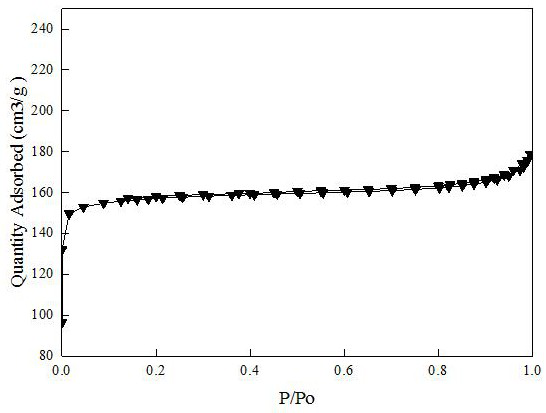Molecular sieve confinement metal oxide catalyst, and preparation method and application of molecular sieve confinement metal oxide catalyst in catalytic synthesis of pentamethylene diamine
A molecular sieve and catalyst technology, which is applied in the field of molecular sieve-confined metal oxide catalysts and preparation, can solve the problem of low selectivity of pentamethylenediamine, achieve the effects of reducing production costs, maintaining a good catalyst structure, and avoiding agglomeration
- Summary
- Abstract
- Description
- Claims
- Application Information
AI Technical Summary
Problems solved by technology
Method used
Image
Examples
Embodiment 1
[0023] The preparation method of the molecular sieve confined metal oxide catalyst in this embodiment is as follows:
[0024] The Ru@FAU-1 catalyst was prepared by combining in-situ synthesis and static synthesis. The specific preparation steps were as follows: dissolve 5.6 g of sodium hydroxide in 50 ml of deionized water, stir vigorously until completely dissolved, and then add 0.675 g of metaaluminic acid Sodium, after the mixed solution is stirred evenly, add 25.38 g of silica sol (silica containing 25%), then add 0.665 g of ruthenium trichloride, stir the resulting mixed solution at room temperature for 4 hours, then transfer it to a stainless steel reaction kettle, and place it in a 100 °C oven Medium crystallization for 12 h. After the reaction was completed, the reactor was cooled to room temperature, the suspension was poured into a centrifuge tube, centrifuged, washed with deionized water until the pH was equal to 7, and dried in an oven at 80°C overnight to prepare ...
Embodiment 2
[0029] The preparation method of the molecular sieve confined metal oxide catalyst in this embodiment is as follows:
[0030] The 5% Ru@FAU-2 catalyst was prepared by combining in-situ synthesis and static synthesis. The specific preparation steps were as follows: dissolve 5.6 g of sodium hydroxide in 50 ml of deionized water, stir vigorously until completely dissolved, and then add 0.675 g Sodium metaaluminate, after the mixed solution is stirred evenly, add 4.23 g of silica sol (silicon dioxide contains 25%), then add 0.342 g of ruthenium trichloride, and the resulting mixed solution is stirred at room temperature for 4 hours and then transferred to a stainless steel reactor. Crystallized in an oven at 100 °C for 12 h. After the reaction was completed, the reactor was cooled to room temperature, the suspension was poured into a centrifuge tube, centrifuged, washed with deionized water until the pH was equal to 7, and then dried in an oven at 80°C overnight to obtain 5% Ru@FA...
Embodiment 3
[0035] The preparation method of the molecular sieve confined metal oxide catalyst in this embodiment is as follows:
[0036] The method of combining in-situ synthesis and static synthesis was adopted, and Ru@FAU-3 catalyst was prepared by dealumination with citric acid. The specific preparation steps were as follows: 5.6 g of sodium hydroxide was dissolved in 50 ml of deionized water, stirred vigorously until completely dissolved, Then add 0.675g sodium metaaluminate to it, add 25.38g silica sol (silicon dioxide contains 25%) after the mixed solution is stirred evenly, then add 0.665g ruthenium trichloride, stir the gained mixed solution at room temperature for 4 hours, then transfer to In a stainless steel reactor, crystallize in an oven at 100 °C for 12 h. After the reaction was completed, the reactor was cooled to room temperature, the suspension was poured into a centrifuge tube, centrifuged, washed with deionized water until the pH was equal to 7, dried in an oven at 80°...
PUM
| Property | Measurement | Unit |
|---|---|---|
| specific surface area | aaaaa | aaaaa |
| specific surface area | aaaaa | aaaaa |
Abstract
Description
Claims
Application Information
 Login to View More
Login to View More - R&D
- Intellectual Property
- Life Sciences
- Materials
- Tech Scout
- Unparalleled Data Quality
- Higher Quality Content
- 60% Fewer Hallucinations
Browse by: Latest US Patents, China's latest patents, Technical Efficacy Thesaurus, Application Domain, Technology Topic, Popular Technical Reports.
© 2025 PatSnap. All rights reserved.Legal|Privacy policy|Modern Slavery Act Transparency Statement|Sitemap|About US| Contact US: help@patsnap.com



